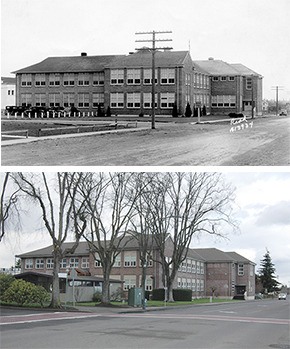With time, a handful of Sequim’s landmark structures have aged, yet still stand as quiet reminders of the past. In this series Sequim Gazette staff take a step back in time to compare these structures now from then and revisit the history, giving insight into the area’s early development.
The face and feel of the Sequim School District has evolved greatly since county commissioners first levied a mill tax for schools in 1859.
By 1861, a one-room school on the Abernethy farm, nested in the Dungeness Valley, opened for three-month summer school.
During the second half of the 1800s and early 1900s and as the population blossomed in eastern Clallam County, more than 20 small schoolhouses served the community stretching between Blyn and Carlsborg.
In time, however, the one-room schoolhouses that used to dot the surrounding prairie and foothills were consolidated to only a few buildings within a single school district.
Sequim’s 1868 one-room schoolhouse quickly reached capacity and additional space was needed for the growing number of students. In 1911, a wooden two-story school was built and housed the district’s first graduating class of four in 1915.
The eight-room wooden schoolhouse was demolished in 1952, but it had long been replaced by the standing brick school along Sequim Avenue completed in 1922.
The school has since undergone additions in 1932 and again in 1935 when the auditorium was added. The school also has endured ongoing remodels in 1954, 1972 and the early 2000s.
“The evolution of our high school campus is interesting,” John McAndie, Sequim School District maintenance and operations supervisor, said. “I think it’s pretty amazing that our community had the forethought coming out of the Great Depression to build something like an auditorium and put value in something like that for the community.”
The auditorium seats still used today date back to 1935 and range from 18 to 21 inches in width depending on the aisle to allow for the correct number of seats, McAndie explained.
“That’s just how they designed things back then,” he said.
Throughout the decades, the school has become a collage of eras. Parts of the historical structure remain while other buildings have been built around it to create the campus most are familiar with.
Although numerous remodels and additions have distorted the appearance of the school, its function has remained as a space to foster education. Continuing to pave the way for additional Sequim students to follow, the last graduation in 2014 saw 205 students graduate from Sequim High School, greatly growing from the four graduates nearly a century ago.



